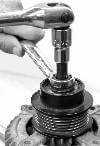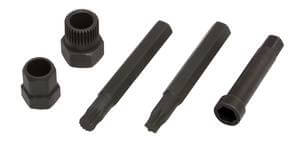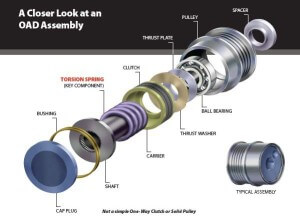How to replace an alternator decoupler pulley
Learn how to replace an Alternator Decoupler Pulley (OAD) or an Overrunning Alternator Pulley (OAP)
The alternators in many late-model vehicles are equipped with either an overrunning alternator decoupled (OAD) pulley or an overrunning alternator pulley (OAP). Both pulley styles are designed to allow the alternator to decouple from the drive belt, allowing the alternator to free-wheel during engine deceleration. However, the two styles are designed differently and are not interchangeable. So, when the pulley fails, it’s important to replace it with the correct type.
How to replace an OAD pulley
1) Secure the alternator in a vise
2) Use a screwdriver to remove the plastic cap. You cannot reuse the cap once you’ve removed it.
3) Install the removal tool in the hex recess and use the appropriate socket and wrench to remove the pulley.
4) Once loosened, spin the OAD off and screw on the replacement. Tighten to manufacturer specs.
Why carmakers use an alternator overrunning or decoupler pulley
Engines don’t produce smooth power. Instead, they produce power in pulses. Each power pulse causes the crankshaft to pull on the drive belt, tightening it and causing the tensioner to move. Between power pulses, the drive belt relaxes, and the tensioner moves to take up the slack. That’s why an automatic belt tensioner always shows some movement.
Here’s how power pulses affect the alternator. The rotor inside
a typical alternator weighs about 3.5 lbs. During engine acceleration, the heavy rotor resists the belt’s rotational motion. This effect is amplified because the alternator typically spins about three times faster than the engine due to the difference in pulley sizes between the crankshaft and alternator. This speed differential often leads to a phenomenon called the “rope-tow effect,” where the belt speed and alternator speed become mismatched.
While belt tensioners can mitigate some of the resulting vibration, the serpentine belt ultimately absorbs most of this harmful stress. This mismatch in speeds and the resulting forces can significantly impact the belt’s longevity and overall system efficiency.
To combat the rope-tow effect and drive belt system wear, carmakers decouple the rotor from the belt, using either an OAD or OAP style pulley that allows the alternator rotor to free-wheel between power pulses.
Advantages of a decoupling alternator pulley
• A decoupling pulley helps absorb and dampen vibrations from the engine’s crankshaft.
• Improves fuel efficiency by reducing parasitic losses (rotor drag) as the engine is decelerating.
• Extends belt life: The pulley reduces stress on the serpentine belt during rapid deceleration, potentially increasing the belt’s lifespan.
• Enhances alternator durability: By reducing shock loads on the alternator during sudden engine speed changes, the decoupling pulley can help prolong the alternator’s operational life.
• Better engine start-stop functionality: In vehicles with start-stop systems, the decoupling pulley allows for smoother restarts by reducing the initial load on the engine.
• Noise reduction: The pulley can help minimize belt chirp and other noises associated with rapid changes in engine speed.
OAD alternator pulley versus an OAP pulley
OAD pulleys are only manufactured by Litens. Their OAD pulley differs significantly from other “clutched” style OAP pulleys. If you install an OAP pulley on an alternator designed for an OAD pulley, you’ll introduce drive belt problems.
How does an OAD pulley work and how is it different from an OAP pulley
An OAP pulley is simply a one-way clutch that applies drive motion to the alternator’s rotor during each power pulse and allows the rotor to free-wheel between power pulses. However, an OAP pulley doesn’t have a speed-matching spring or avibration-dampening mechanism like an OAD pulley.

In this cutaway view of a Litens over-running alternator decoupler (OAD) pulley, you see the spring that helps the mismatch between belt and rotor speeds. And, the plastic piece dampens belt vibrations.
The OAD pulley’s internal spring absorbs the rotational force generated by belt acceleration and deceleration speed fluctuations. The clutch mechanism also decouples the alternator’s rotor from the drive belt during sudden engine deceleration, allowing the rotor to overrun or free-wheel.
How an OAP pulley works
An OAP pulley is built with a one-way clutch that drives the alternator rotor during power pulses and allows it to free-wheel during engine deceleration. It has no speed-matching or dampening mechanism.
How do you tell the difference between an OAD and an OAP pulley?
Turn the pulley in one direction and then rotate in the opposite direction. An OAD pulley will rotate freely in one direction and offer a limited, spring-like movement in the other direction.
An OAP pulley will rotate in one direction and won’t allow rotation in the other direction.
What happens if you use an OAP pulley on a vehicle designed for an OAD pulley?
Because the drive belt system is specifically designed for either an OAD or OAP pulley, using the wrong pulley can result in extreme belt tension issues, severe vibration, and extreme noise, vibration, and harshness. Using the wrong pulley can cause vibration damage to other driven components.
Who manufactures OAD pulleys?
The OAD™ pulley design is patented by Litens Automotive Group, a global manufacturer of original equipment and replacement components for the transportation industry. Litens is also the exclusive manufacturer of OAD™ pulleys for original equipment alternator manufacturers as well as customers in the replacement parts market.
Symptoms of a worn Overrunning Alternator Decoupler
• Buzzing noise— If you raise the engine speed to 2,000-2,500 rpm, shut off the engine, and hear a buzzing noise, the OAD is worn out and must be replaced.
• The pulley rotates easily in both directions. Replace the pulley
©, 2013 Rick Muscoplat
Posted on by Rick Muscoplat






